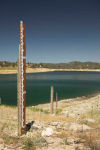Elevated levels of radioactivity, salts and metals have been found in river water and sediments at a site where treated water from oil and gas operations is discharged into a western Pennsylvania creek.
Related Articles
"Radium levels were about 200 times greater in sediment samples collected where the Josephine Brine Treatment Facility discharges its treated wastewater into Blacklick Creek than in sediment samples collected just upstream of the plant," said Avner Vengosh, professor of geochemistry and water quality at Duke University's Nicholas School of the Environment.
The new Duke study examined the quality of shale gas wastewater from hydraulic fracturing and the stream water above and below the disposal site. The study found that some of the discharged effluent is derived from the Marcellus shale gas flowback water, which is naturally high in salinity and radioactivity.
High concentrations of some salts and metals were also observed in the stream water. "The treatment removes a substantial portion of the radioactivity, but it does not remove many of the other salts, including bromide," Vengosh said. "When the high-bromide effluents are discharged to the stream, it increases the concentrations of bromide above the original background levels. This is significant because bromide increases the risks for formation of highly toxic disinfection byproducts in drinking water treatment facilities that are located downstream."
"The radioactivity levels we found in sediments near the outflow are above management regulations in the U.S. and would only be accepted at a licensed radioactive disposal facility," said Robert B. Jackson, professor of environmental science at Duke. "The facility is quite effective in removing metals such as barium from the water but concentrates sulfates, chlorides and bromides. In fact this single facility contributes four-fifths of the total downstream chloride flow at this point."
The Duke team also analyzed stream-bottom sediments for radium isotopes that are typically found in Marcellus wastewater. "Although the facility's treatment process significantly reduced radium and barium levels in the wastewater, the amount of radioactivity that has accumulated in the river sediments still exceeds thresholds for safe disposal of radioactive materials," Vengosh said. "Years of disposal of oil and gas wastewater with high radioactivity has created potential environmental risks for thousands of years to come."
"While water contamination can be mitigated by treatment to a certain degree, our findings indicate that disposal of wastewater from both conventional and unconventional oil and gas operations has degraded the surface water and sediments," said Nathaniel R. Warner, a recent Ph.D. graduate of Duke who is now a postdoctoral researcher at Dartmouth College. "This could be a long-term legacy of radioactivity."
Industry has made efforts to reuse or to transport shale gas wastewater to deep injection wells, but wastewater is still discharged to the environment in some states. "It is clear that this practice of releasing wastewater without adequate treatment should be stopped in order to protect freshwater resources in areas of oil and gas development," Vengosh said.
The Duke team published their findings Oct. 2 in the peer-reviewed journal Environmental Science & Technology.
Story Source:
The above story is based on materials provided by Duke University. Note: Materials may be edited for content and length.
Journal Reference:
- Nathaniel R. Warner, Cidney A. Christie, Robert B. Jackson, Avner Vengosh. Impacts of Shale Gas Wastewater Disposal on Water Quality in Western Pennsylvania. Environmental Science & Technology, 2013; 131002090059009 DOI: 10.1021/es402165b
Cite This Page:












